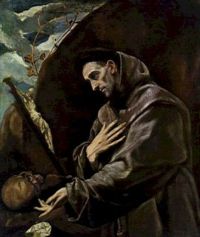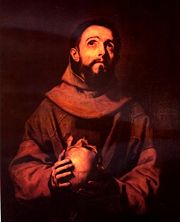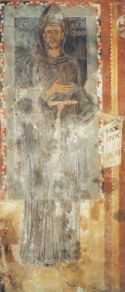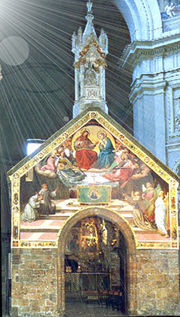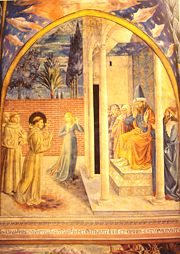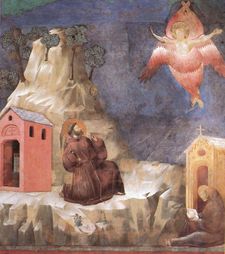Francis of Assisi
2008/9 Schools Wikipedia Selection. Related subjects: Religious figures and leaders
| Saint Francis of Assisi | |
|---|---|
| El Greco, Saint Francis in Prayer, 1580–85, oil on canvas, 115.5 x 103 cm. Joslyn Art Museum | |
| Confessor | |
| Born | 1181 or 1182, Assisi, Italy |
| Died | 3 October 1226, Assisi, Italy |
| Venerated in | Roman Catholic Church |
| Canonized | 16 July 1228, Assisi by Pope Gregory IX |
| Major shrine | Basilica of San Francesco d'Assisi |
| Feast | 4 October |
| Attributes | Dove, Stigmata, poor Franciscan habit, cross, Pax et Bonum |
| Patronage | animals, merchants, Italy, Meycauayan, Philippines, Catholic Action, the environment, stowaways |
Saint Francis of Assisi (born Giovanni Francesco Bernardone) ( 1181 or 1182 – 3 October 1226) was a Roman Catholic friar and the founder of the Order of Friars Minor, more commonly known as the Franciscans.
He is known as the patron saint of animals, birds, the environment, and Italy, and it is customary for Catholic churches to hold ceremonies honoring animals around his feast day of October 4.
Childhood and early adulthood
Francis was born to Pietro di Bernardone, a rich cloth merchant, and his wife Pica Bourlemont, about whom little is known except that she was originally from France. He was one of seven children. Pietro was in France on business when Francis was born, and Pica had him baptized as Giovanni di Bernardone in honour of Saint John the Baptist, in the hope he would grow to be a great religious leader. When his father returned to Assisi, he was furious about this, as he did not want his son to be a man of the Church and decided to call him Francesco (an adjective meaning French in Italian), in honour of his commercial success and enthusiasm for all things French.
As a youth, Francesco--or Francis in English--became a troubador and yearned to become a writer of French poetry. Although many biographers remark about his bright clothing, rich friends, street brawls, and love of pleasure; his displays of disillusionment toward the world that surrounded him became fairly early, as is shown in the "story of the beggar". In this account, he was selling cloth and velvet in the marketplace on behalf of his father when a beggar came to him and asked for alms. At the conclusion of his business deal, Francis abandoned his wares and ran after the beggar. When he found him, Francis gave the man everything he had in his pockets. His friends quickly chided and mocked him for his act of charity. When he got home, his father scolded him in rage. It is probable that his conversion to more serious thoughts was a gradual process relating to this experience. After his return to Assisi in 1203, Francis recommenced his carefree life. In 1204, however, a serious illness started a spiritual crisis. In 1205 Francis left for Puglia to enlist in the army of the Count of Brienne. In Spoleto, a strange vision made him return to Assisi, deepening his spiritual crisis.
It is said that thereafter he began to avoid the sports and the feasts of his former companions; in response, they asked him laughingly whether he was thinking of marrying, to which he answered "yes, a fairer bride than any of you have ever seen", meaning his "lady poverty". He spent much time in lonely places, asking God for enlightenment. By degrees he took to nursing lepers, the most repulsive victims in the lazar houses near Assisi. After a pilgrimage to Rome, where he begged at the church doors for the poor, he claimed to have had a mystical experience in the Church of San Damiano just outside of Assisi, in which the Icon of Christ Crucified came alive and said to him three times, "Francis, Francis, go and repair My house which, as you can see, is falling into ruins". He thought this to mean the ruined church in which he was presently praying, and so sold his horse and some cloth from his father's store, to assist the priest there for this purpose.
His father Pietro, highly indignant, attempted to change his mind, first with threats and then with corporal chastisement. After a final interview in the presence of the bishop, Francis renounced his father and his patrimony, laying aside even the garments he had received from him. For the next couple of months he lived as a beggar in the region of Assisi. Returning to the town for two years this time, he restored several ruined churches, among them the Porziuncola, little chapel of St Mary of the Angels, just outside the town, which later became his favorite abode.
Founding of the Order of Friars Minor
At the end of this period (according to Jordanus, on 24 February 1209), Francis heard a sermon that changed his life. The sermon was about Matthew 10:9, in which Christ tells his followers that they should go forth and proclaim that the Kingdom of Heaven was upon them, that they should take no money with them, nor even a walking stick or shoes for the road. Francis was inspired to devote himself to a life of poverty.
Clad in a rough garment, barefoot, and, after the Evangelical precept, without staff or scrip, he began to preach repentance. He was soon joined by his first follower, a prominent fellow townsman, the jurist Bernardo di Quintavalle, who contributed all that he had to the work. Within a year Francis had eleven followers. Francis chose never to be ordained a priest and the community lived as "lesser brothers," fratres minores in Latin.
The brothers lived a simple life in the deserted lazar house of Rivo Torto near Assisi; but they spent much of their time wandering through the mountainous districts of Umbria, always cheerful and full of songs, yet making a deep impression on their hearers by their earnest exhortations.
In 1209 Francis led his first eleven followers to Rome to seek permission from Pope Innocent III to found a new religious order. Upon entry to Rome, the brothers encountered Bishop Guido of Assisi, who had in his company the cardinal bishop of Sabina, Lord John of St Paul. The Cardinal, who was the confessor of Pope Innocent III, was immediately sympathetic to Francis and agreed to represent Francis to the pope. Reluctantly, Pope Innocent agreed to meet with Francis and the brothers the next day. After several days, the pope agreed to informally admit the group, adding that when God increased the group in grace and number, they could return for an official admittance. The group was tonsured and Francis was ordained as a deacon, allowing him to read Gospels in the church.
Later life
From then on, his new order grew quickly with new vocations. When hearing Francis preaching in the church of San Rufino in Assisi in 1209, Clare of Assisi became deeply touched by his message and she realized her calling. Her brother Rufino also joined the new order.
On Palm Sunday, 28 March 1211 Francis received Clare at the Porziuncola and hereby established the Order of Poor Dames, later called Poor Clares. In the same year, Francis left for Jerusalem, but he was shipwrecked by a storm on the Dalmatian coast, forcing him to return to Italy.
On 8 May 1213 he received the mountain of La Verna (Alverna) as a gift from the count Orlando di Chiusi who described it as “eminently suitable for whoever wishes to do penance in a place remote from mankind.” The mountain would become one of his favorite retreats for prayer. In the same year, Francis sailed for Morocco, but this time an illness forced him to break off his journey in Spain. Back in Assisi, several noblemen (among them Tommaso da Celano, who would later write the biography of St. Francis) and some well-educated men joined his order.
In 1215 Francis went again to Rome for the Fourth Lateran Council. During this time, he probably met Dominic de Guzman.
In 1216 Francis received from the new pope Honorius III the confirmation of the indulgence of the Porziuncola, now better known as the Pardon of Assisi, which the Pope decreed to be a complete remission of their sins for all those who prayed in the Porziuncola.
In 1217 the growing congregation of friars was divided in provinces and groups were sent to France, Germany, Hungary, Spain and to the East.
In 1219 Francis left, together with a few companions, on a pilgrimage of non-violence to Egypt. Crossing the lines between the sultan and the Crusaders in Damietta, he was received by the sultan Melek-el-Kamel. Francis challenged the Muslim scholars to a test of true religion by fire; but they retreated. When Francis proposed to enter the fire first, under the condition that if he left the fire unharmed, the sultan would have to recognize Christ as the true God, the sultan was so impressed that he allowed Francis to preach to his subjects. Though Francis did not succeed in converting the sultan, the last words of the sultan to Francis of Assisi were, according to Jacques de Vitry, bishop of Acre, in his book "Historia occidentalis, De Ordine et praedicatione Fratrum Minorum (1221)" : “Pray for me that God may deign to reveal to me that law and faith which is most pleasing to him.”.
At Acre, the capital of what remained of the Kingdom of Jerusalem, he rejoined the brothers Elia and Pietro Cattini. Francis then most probably visited the holy places in Palestine in 1220.
Although nativity drawings and paintings existed earlier, St Francis of Assisi celebrated Christmas by setting up the first known three-dimensional presepio or crèche ( Nativity scene) in the town of Greccio near Assisi, around 1220. He used real animals to create a living scene so that the worshipers could contemplate the birth of the child Jesus in a direct way, making use of the senses, especially sight. Thomas of Celano, a biographer of Francis and Saint Bonaventure both tell how he only used a straw-filled manger (feeding trough) set between a real ox and donkey. According to Thomas, it was beautiful in its simplicity with the manger acting as the altar for the Christmas Mass.
When receiving a report of the martyrdom of five brothers in Morocco, Francis returned to Italy via Venice. Cardinal Ugolino di Conti was then nominated by the Pope as the protector of the order. When problems arose in the order, a detailed rule became necessary. On 29 September 1220 Francis handed over the governance of the order to brother Pietro Cattini at the Porziuncola. However, Brother Cattini died on 10 March 1221. He was buried in the Porziuncola. When numerous miracles were attributed to the late Pietro Cattini, people started to flock to the Porziuncola, disturbing the daily life of the Franciscans. Francis then prayed, asking Pietro to stop the miracles and obey in death as he had obeyed during his life. The report of miracles ceased. Brother Pietro was succeeded by brother Elia as vicar of Francis.
During 1221 and 1222 Francis crossed Italy, first as far south as Catania in Sicily and afterwards as far north as Bologna.
On 29 November 1223 the final rule of the order (in twelve chapters) was approved by Pope Honorius III.
While he was praying on the mountain of Verna, during a forty day fast in preparation for Michaelmas, Francis is said to have had a vision on or about 14 September 1224, the Feast of the Exaltation of the Cross, as a result of which he received the stigmata. Brother Leo, who had been with Francis at the time, left a clear and simple account of the event, the first definite account of the phenomenon of stigmata. "Suddenly he saw a vision of a seraph, a six-winged angel on a cross. This angel gave him the gift of the five wounds of Christ."
Suffering from these Stigmata and from an eye disease, he received care in several cities ( Siena, Cortona, Nocera) to no avail. In the end he was brought back to the Porziuncola. He was brought to the transito, the hut for infirm friars, next to the Porziuncola. Here, in the place where it all began, feeling the end approaching, he spent the last days of his life dictating his spiritual testament. He died on the evening of 3 October 1226 singing Psalm 141. His feast day is observed 4 October.
On 16 July 1228 he was pronounced a saint by the next pope Gregory IX, the former cardinal Ugolino di Conti, friend and protector of St. Francis. The next day, the pope laid the foundation stone for the Basilica of Saint Francis in Assisi.
He was buried on 25 May 1230 under the Lower Basilica. His burial place remained inaccessible until it was rediscovered in 1818. Pasquale Belli then constructed for his remains a crypt in neo-classical style under the Lower Basilica. It was refashioned between 1927 and 1930 into its present form by Ugo Tarchi, stripping the wall of its marble decorations. In 1978 the remains of St. Francis were identified by a commission of scholars, appointed by pope Paul VI and put in a glass urn in the ancient stone tomb.
St. Francis is considered the first Italian poet by literary critics. He believed commoners should be able to pray to God in their own language, and he wrote always in dialect of Umbria instead of Latin. His writings are considered to have great literary value, as well as religious.
Saint Francis, nature, and the environment
Many of the stories that surround the life of St Francis deal with his love for animals. Perhaps the most famous incident that illustrates the Saint’s humility towards nature is recounted in the 'Fioretti' (The "Little Flowers"), a collection of legends and folk-lore that sprang up after the Saint’s death. It is said that one day while Francis was traveling with some companions they happened upon a place in the road where birds filled the trees on either side. Francis told his companions to "wait for me while I go to preach to my sisters the birds". The birds surrounded him, drawn by the power of his voice, and not one of them flew away. Francis spoke to them:
My sister birds, you owe much to God, and you must always and in everyplace give praise to Him; for He has given you freedom to wing through the sky and He has clothed you…you neither sow nor reap, and God feeds you and gives you rivers and fountains for your thirst, and mountains and valleys for shelter, and tall trees for your nests. And although you neither know how to spin or weave, God dresses you and your children, for the Creator loves you greatly and He blesses you abundantly. Therefore… always seek to praise God.
Another legend from the Fioretti tells that in the city of Gubbio, where Francis lived for some time, was a wolf “terrifying and ferocious, who devoured men as well as animals”. Francis had compassion upon the townsfolk, and went up into the hills to find the wolf. Soon, fear of the animal had caused all his companions to flee, though the saint pressed on. When he found the wolf, he made the sign of the cross and commanded the wolf to come to him and hurt no one. Miraculously the wolf closed his jaws and lay down at the feet of St. Francis. “Brother Wolf, you do much harm in these parts and you have done great evil…” said Francis. “All these people accuse you and curse you…But brother wolf, I would like to make peace between you and the people.” Then Francis led the wolf into the town, and surrounded by startled citizens made a pact between them and the wolf. Because the wolf had “done evil out of hunger”, the townsfolk were to feed the wolf regularly, and in return, the wolf would no longer prey upon them or their flocks. In this manner Gubbio was freed from the menace of the predator. Francis, ever the lover of animals, even made a pact on behalf of the town dogs, that they would not bother the wolf again.
These legends exemplify the Franciscan mode of charity and poverty as well as the saint's love of the natural world. Part of his appreciation of the environment is expressed in his Canticle of the Sun, a poem written in Umbrian Italian in perhaps 1224 which expresses a love and appreciation of Brother Sun, Sister Moon, Mother Earth, Brother Fire, etc. and all of God's creations personified in their fundamental forms. In "Canticle of the Creatures," he wrote: "All praise to you, Oh Lord, for all these brother and sister creatures."
Francis's attitude towards the natural world, while poetically expressed, was conventionally Christian. He believed that the world was created good and beautiful by God but suffers a need for redemption because of the primordial sin of man. He preached to man and beast the universal ability and duty of all creatures to praise God (a common theme in the Psalms) and the duty of men to protect and enjoy nature as both the stewards of God's creation and as creatures ourselves.
Legend has it that St. Francis on his deathbed thanked his donkey for carrying and helping him throughout his life, and his donkey wept.
Main writings by St. Francis
- Canticum Fratris Solis or Laudes Creaturarum, Canticle of the Sun.
- Prayer before the Crucifix, 1205 (extant in the original Umbrian dialect as well as in a contemporary Latin translation).
- Regula non bullata, the Earlier Rule, 1221.
- Regula bullata, the Later Rule, 1223.
- Testament, 1226.
- Admonitions.
- The Little Flowers of Saint Francis (Translated by Raphael Brown), Doubleday, 1998. ISBN 978-0-385-07544-2
For a complete list, see .
